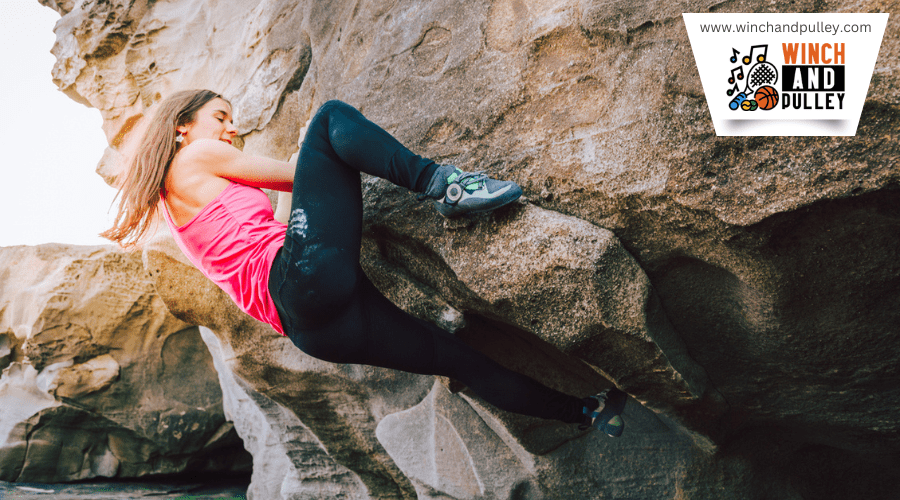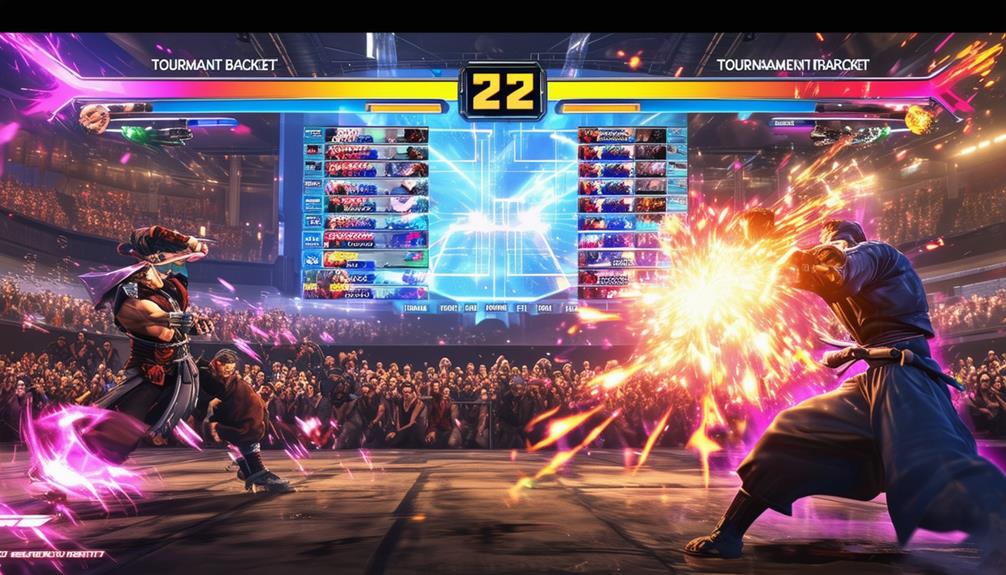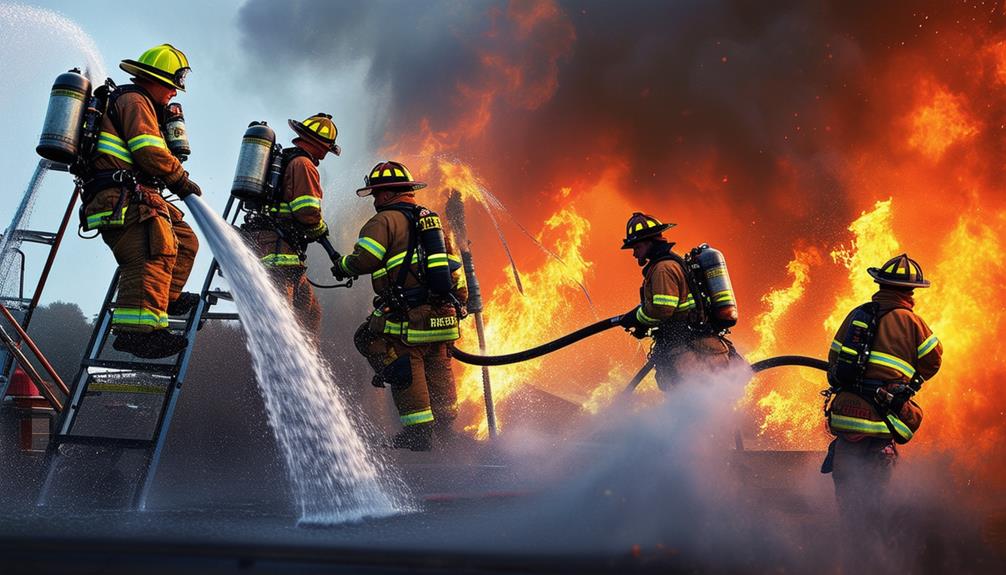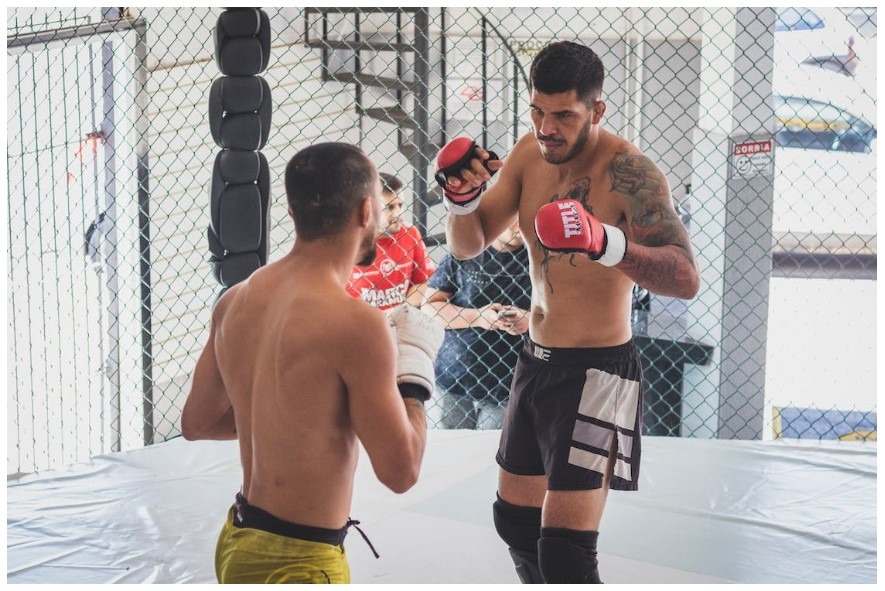Blindfolded Martial Arts: Fighting Without Sight
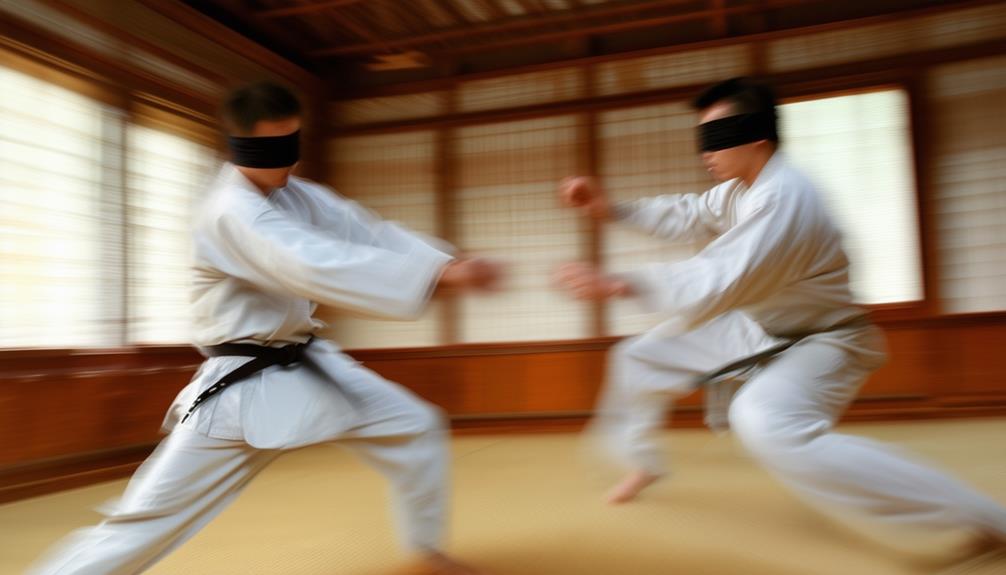
Imagine finding yourself in a situation where your vision is compromised and you need to defend yourself. Blindfolded martial arts prepares you for this exact scenario by training you to rely on heightened tactile sensitivity and spatial awareness.
Through practice, you'll master techniques like Blindfolded Chi Sao, which enables you to detect opponents through sound and touch. This rigorous training not only enhances your combat skills but also improves your mental focus and adaptability. How do these techniques translate to real-world self-defense? This exploration into the fascinating practice of blindfolded martial arts is just beginning.
Key Takeaways
- Blindfolded martial arts training enhances tactile sensitivity and spatial awareness, allowing for effective combat without the use of sight.
- Practicing blindfolded Chi Sao in Wing Chun improves grip recognition and fosters intuitive responses to an opponent's movements.
- Training without sight boosts proprioception, muscle memory, and precise execution of movements.
- Sensory deprivation exercises sharpen mental focus and adaptability, relying on tactile and auditory feedback.
- Blindfolded sparring enhances self-defense skills by simulating scenarios where visual cues are absent, thereby improving real-life applicability.
History of Blindfolded Martial Arts

Blindfolded martial arts training dates back to ancient times, where warriors honed their sensory awareness and combat skills without sight. Historical martial arts masters used these techniques to sharpen their senses, improve reflexes, and develop strategic thinking in battle.
One notable practice is Chi Sao, or 'Sticky Hands,' from Wing Chun. This exercise involves two practitioners maintaining contact with each other's arms, feeling and reacting to movements without relying on vision.
Blindfolded training wasn't just for sharpening individual skills but also to simulate real-life combat scenarios. Warriors often faced unpredictable situations, and the ability to respond to attacks instinctively was vital. Without sight, they learned to rely on their other senses, enhancing their combat effectiveness.
Traditional martial arts styles incorporated blindfolded training to cultivate a deeper connection between the practitioner's body and their environment. By removing sight, practitioners are forced to heighten their awareness of spatial relationships and physical sensations, resulting in greater precision and fluidity.
Today, blindfolded martial arts practices continue to be integral in refining skills, heightening awareness, and preparing fighters for unpredictable combat situations. The historical roots of these techniques underscore their enduring value and effectiveness.
Benefits of Training Blindfolded
Training without sight deepens your connection with your environment and offers numerous benefits that enhance your martial arts practice. When you train blindfolded, you significantly boost your tactile sensitivity and awareness of your opponent's movements. This is particularly evident in practices like chi sau, where touch is essential. It enables you to respond to attacks through sound and touch, bypassing the need for visual cues.
Focusing on techniques, body positioning, and footwork becomes second nature as you rely more on your proprioception. This heightened sense of body awareness helps you adapt more effectively in unpredictable situations. Training without sight sharpens your concentration, making each movement deliberate and precise.
Additionally, blindfolded training refines muscle memory. As you practice techniques repeatedly without visual input, your body learns to execute them with greater accuracy. This precision translates into more effective and efficient movements during sparring or real-world scenarios.
Incorporating chi sau into your blindfolded practice further magnifies these benefits, enabling you to better anticipate and react to your opponent's actions. Training without sight builds a more intuitive and responsive martial artist.
Key Techniques for Practitioners
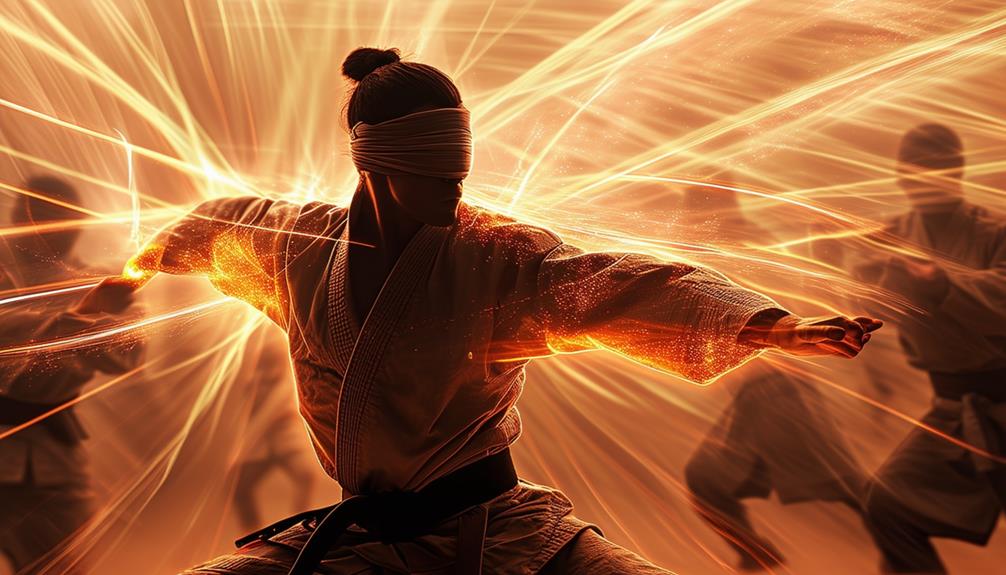
Mastering key techniques in blindfolded martial arts is essential for developing tactile sensitivity and reactive skills. A fundamental exercise is blindfolded Chi Sao, which enhances your ability to sense and respond to your opponent's movements through touch. This drill improves grip recognition, making it easier to detect and counter attacks based on tactile feedback alone.
Another crucial technique is sound-based detection. By refining your auditory senses, you can anticipate movements from the sounds of your opponent's breathing, footsteps, or clothing. This skill is invaluable when vision is impaired, allowing for swift and accurate reactions.
Proper body positioning is also vital. Relying on proprioception—the awareness of your body's position in space—helps you maintain balance and execute techniques effectively. Practicing blindfolded sparring and drills enhances this internal sense, improving adaptability in self-defense scenarios.
Sensory deprivation training challenges you to refine these techniques. The absence of sight forces reliance on other senses, enhancing your ability to predict and counter attacks with heightened precision and awareness.
Developing Tactile Sensitivity
After mastering the fundamental techniques in blindfolded martial arts, the next step is to enhance your tactile sensitivity. This advanced skill enables you to detect and respond to an opponent's body position and movements purely through touch, bypassing the need for sight. By honing this sensitivity, you can perceive subtle shifts in an opponent's Chi, allowing for rapid and effective reactions.
To maximize your training, find a quiet space that minimizes distractions. Here, you can focus on refining your tactile abilities through various techniques that emphasize grips, grabs, and tactile feedback. The following table outlines key elements of this training:
| Technique | Focus Area | Benefit |
|---|---|---|
| Grips | Hand Sensitivity | Improved control |
| Grabs | Arm Sensitivity | Better grasp and hold |
| Tactile Feedback | Whole Body | Enhanced response to movement |
| Chi Awareness | Energy Sensing | Anticipate opponent's actions |
Training in these areas will significantly enhance your ability to detect and counter attacks. Even the slightest touch can provide critical information about your opponent's intentions. Developing your tactile sensitivity not only boosts your combat effectiveness but also deepens your understanding of Chi, making you a more intuitive and responsive martial artist.
Enhancing Spatial Awareness
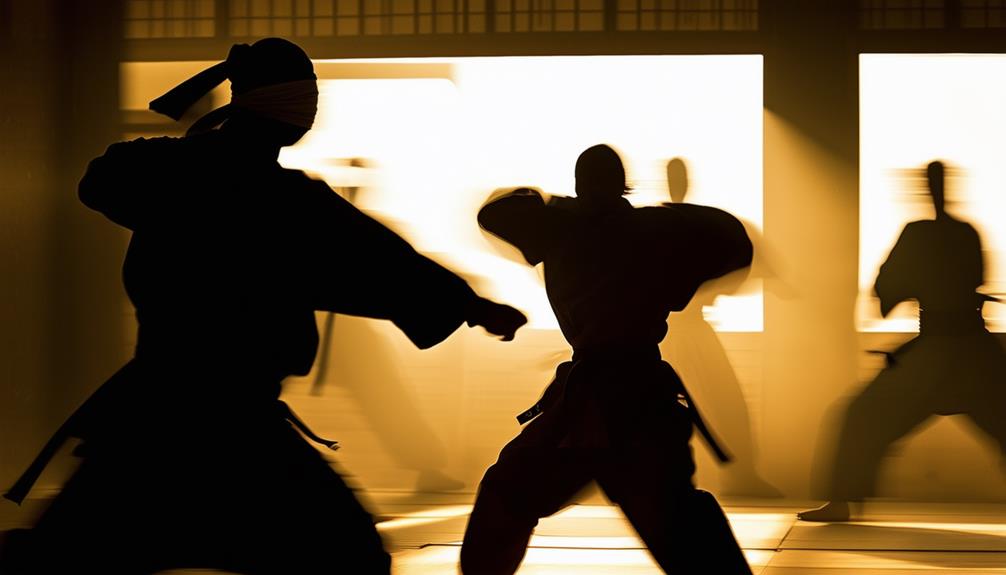
How do you sharpen your spatial awareness when you can't rely on sight? In blindfolded martial arts, navigating and controlling space becomes paramount. Without vision, you lean heavily on tactile feedback and sound cues, which enhances your sense of distance, angles, and opponent positioning.
When blindfolded, you start to notice subtle shifts in your opponent's movements through touch and sound. These cues enable you to anticipate attacks and respond effectively. Over time, your spatial awareness improves, allowing you to manage fights better and position yourself strategically. You become adept at gauging the space around you, which is critical in combat.
Training without sight forces you to refine your awareness of your environment and your opponent's location. This practice translates into improved fight management, as you can navigate and control the combat space more effectively. By honing these skills blindfolded, you become more proficient in anticipating and reacting to your opponent's moves, making you a more formidable martial artist. Enhancing spatial awareness through blindfolded training isn't just an exercise in overcoming a challenge; it's a pathway to mastering strategic positioning in combat.
Training Drills and Exercises
Training while blindfolded engages you in drills that sharpen tactile sensitivity and heighten awareness of an attacker's movements. One effective method is practicing Wing Chun's Chi Sao, or 'sticky hands.' This drill emphasizes maintaining continuous contact with your partner's arms to sense their intentions and respond accordingly. By relying solely on touch, you learn to feel shifts in pressure and direction, allowing for quick, instinctive reactions.
Another crucial exercise involves practicing grips and grabs. With your vision obscured, you must detect and counter attacks based purely on touch and sound. This might include defending against wrist grabs or redirecting incoming strikes. Training in a quiet environment can further enhance your ability to rely on these non-visual cues, honing your reaction times and refining your techniques.
Blindfolded training also improves proprioception and spatial awareness. You'll become more adept at understanding your body's position and movements in space, which is vital for effective self-defense. These drills refine your martial arts techniques, ensuring you can execute them accurately without needing visual confirmation. Embrace the challenge, and you'll find your skills greatly enhanced.
Mental Focus and Adaptability
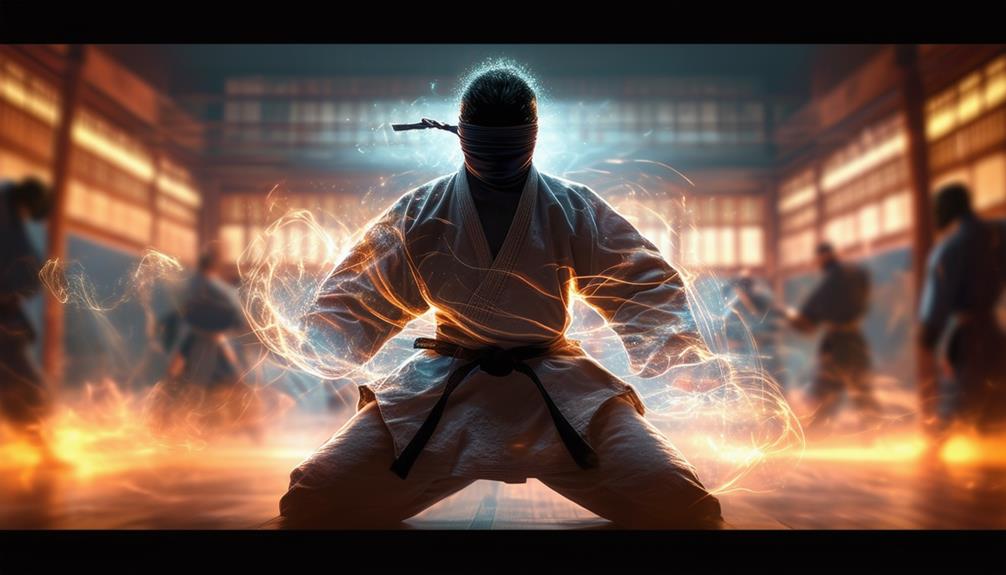
Blindfolded martial arts training sharpens your mental focus and adaptability by eliminating visual cues, forcing you to rely on your other senses. Without sight, you become more attuned to sounds, movements, and even slight changes in air pressure. This heightened awareness demands intense concentration, pushing your mental focus to new heights.
Training without vision also improves adaptability by challenging you to react swiftly to unexpected attacks. You learn to make quick, accurate decisions based on tactile feedback and auditory signals. This ability to stay calm under pressure and adapt to changing situations is invaluable, both in training and real-life self-defense scenarios.
Safety Considerations
Ensuring safety during blindfolded martial arts training is crucial to minimize the risk of injury. With your eyes closed, the likelihood of accidents increases, so training in a clear space free from obstacles and hazards is essential. This controlled environment helps prevent unnecessary accidents.
Proper supervision and guidance are essential components. An experienced instructor can provide immediate feedback and assistance, preventing injuries during blindfolded techniques. Before attempting any drills with your eyes closed, you should be well-versed in basic techniques. This foundational knowledge reduces risks and ensures safe execution of moves even without visual cues. Protective gear is also critical. Using padded mats, gloves, and headgear can significantly reduce the impact of accidental collisions or falls, allowing you to train more confidently.
Finally, regular communication and feedback between you and your training partners are vital. Clear communication helps maintain a safe environment, enabling everyone involved to adjust and respond appropriately during blindfolded practice.
Real-World Applications

In real-world self-defense scenarios, blindfolded martial arts training can significantly enhance your tactile sensitivity and spatial awareness. By practicing without visual input, you learn to rely on other senses, which is crucial when vision is compromised or unavailable.
Here are some real-world applications of blindfolded martial arts training:
- Enhanced Reflexes: Engaging in blindfolded sparring and drills sharpens your reflexes. You learn to react swiftly to physical cues, preparing you to handle sudden attacks where vision isn't an option.
- Improved Adaptability: Techniques like blindfolded Chi Sau from Wing Chun enhance your ability to adapt to an opponent's movements. This adaptability is vital in chaotic real-life encounters where visual cues are limited.
- Heightened Sensory Perception: Training blindfolded develops acute sensitivity to sound and touch. This heightened perception enables you to detect and respond to threats more effectively, even in low-visibility situations.
Incorporating these techniques into your martial arts practice equips you with the necessary skills to sense and respond to potential dangers using tactile and auditory information. The real-world applications of blindfolded martial arts underscore the importance of developing a well-rounded sensory skill set for self-defense.
Frequently Asked Questions
Is It Possible to Fight Without Seeing?
Yes, it is possible to fight without seeing. By developing tactile awareness, listening for auditory cues, and enhancing muscle memory, you can effectively sense and counter attacks, making you capable in combat even without vision.
Has There Ever Been a Blind Martial Artist?
Yes, there have been blind martial artists who have excelled in various styles. They rely on heightened senses and specialized training to master their craft, proving that sight is not essential for success in martial arts.
What Is the Best Martial Art for Bad Eyesight?
Consider grappling styles like Judo or Brazilian Jiu-Jitsu (BJJ), which emphasize tactile awareness. Wing Chun and Greco-Roman wrestling are also suitable due to their focus on sensitivity and clinch control, making them effective for individuals with bad eyesight.
Can You Learn to Fight Blind?
Yes, you can learn to fight without the use of sight. Focus on developing sensory awareness and tactile skills through blindfolded training. Techniques like Chi Sao from Wing Chun and grappling styles such as Judo and Brazilian Jiu-Jitsu (BJJ) can greatly enhance your ability to fight without relying on vision.
Conclusion
By training in blindfolded martial arts, you'll enhance your tactile sensitivity and spatial awareness, making you more adaptable in various situations. This practice develops the mental focus required to react swiftly and accurately, even when sight is compromised. With proper guidance and safety measures, you can master these techniques, gaining a unique advantage in self-defense. Embrace the challenge and discover how fighting without sight can elevate your martial arts skills to new heights.

